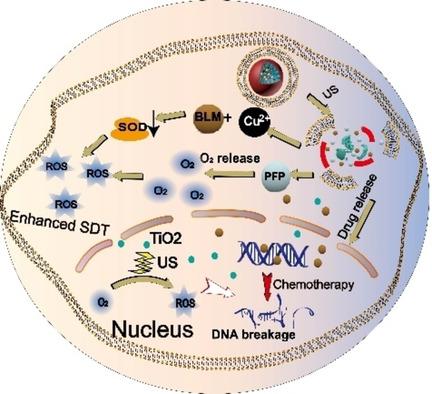当前位置:
X-MOL 学术
›
ChemNanoMat
›
论文详情
Our official English website, www.x-mol.net, welcomes your feedback! (Note: you will need to create a separate account there.)
An Ultrasound‐Triggered ROS Sustained Supplier Based on Open Source and Reduce Expenditure Strategy for Colon Cancer Therapy
ChemNanoMat ( IF 3.8 ) Pub Date : 2020-05-18 , DOI: 10.1002/cnma.202000172 Huijuan Zhang 1, 2, 3 , Fang Cao 1 , Ling Zhu 1, 2, 3 , Lin Hou 1, 2, 3 , Zhenzhong Zhang 1, 2, 3
ChemNanoMat ( IF 3.8 ) Pub Date : 2020-05-18 , DOI: 10.1002/cnma.202000172 Huijuan Zhang 1, 2, 3 , Fang Cao 1 , Ling Zhu 1, 2, 3 , Lin Hou 1, 2, 3 , Zhenzhong Zhang 1, 2, 3
Affiliation

|
The reactive oxygen species (ROS) play a decisive role in sonodynamic therapy (SDT). However, hypoxic microenvironment of tumors and short lifetime of ROS limit the implementation of SDT. In this work, an ultrasound (US)‐triggered ROS sustained supplier based on open source and reduce expenditure strategy was constructed. The mesoporous titanium dioxide nanoparticles (MTN) were used as carriers and sonosensitizers, to load US‐responsive perfluoropentane (PFP) and bleomycin (BLM), a blocking agent to reduce ROS scavenging. Thereafter, nanoparticles were wrapped by red blood cell membrane (RBCm) with TKD modification (TKD@RMPB). Under US irradiation, MTN disintegrated into small TiO2 nanoparticles to release PFP and BLM. PFP effectively supplied O2 to enhance ROS generation. Furthermore, BLM reduced the activity of SOD enzyme so that ROS clearance would decrease. This dual role contributed ROS explosive accumulation in tumor cells. In vitro results showed the ROS level of TKD@RMPB group was 3.62 times that of MTN group. Compared with MTN, the proportion of DNA damage in TKD@RMPB group increased by 2.23 times. Moreover, in vivo results indicated that TKD@RMPB could significantly reduce pulmonary fibrotic lesions caused by BLM, suggesting that TKD@RMPB realized simultaneous chemotherapy and SDT for HT‐29 colon cancer with high efficiency and low toxicity.
中文翻译:

基于开源和减少开支策略的超声触发ROS持续供应商,用于结肠癌治疗
活性氧(ROS)在声动力学治疗(SDT)中起决定性作用。然而,肿瘤的低氧微环境和ROS的短寿命限制了SDT的实施。在这项工作中,构建了一个基于超声波(美国)触发的ROS的持续供应商,该供应商基于开源和减少支出的策略。介孔二氧化钛纳米粒子(MTN)用作载体和声敏剂,以加载US响应性全氟戊烷(PFP)和博来霉素(BLM)(一种可减少ROS清除的封闭剂)。之后,纳米颗粒被具有TKD修饰(TKD @ RMPB)的红细胞膜(RBCm)包裹。在美国辐射下,MTN分解成小的TiO 2纳米颗粒,释放出PFP和BLM。PFP有效供应O 2增强ROS的产生。此外,BLM降低了SOD酶的活性,从而使ROS清除率降低。这种双重作用促使ROS爆炸物在肿瘤细胞中积累。体外实验结果表明,TKD @ RMPB组的ROS水平是MTN组的3.62倍。与MTN相比,TKD @ RMPB组DNA损伤的比例增加了2.23倍。此外,体内结果表明,TKD @ RMPB可以显着减少由BLM引起的肺纤维化病变,这表明TKD @ RMPB实现了HT-29结肠癌同时化疗和SDT的高效,低毒。
更新日期:2020-05-18
中文翻译:

基于开源和减少开支策略的超声触发ROS持续供应商,用于结肠癌治疗
活性氧(ROS)在声动力学治疗(SDT)中起决定性作用。然而,肿瘤的低氧微环境和ROS的短寿命限制了SDT的实施。在这项工作中,构建了一个基于超声波(美国)触发的ROS的持续供应商,该供应商基于开源和减少支出的策略。介孔二氧化钛纳米粒子(MTN)用作载体和声敏剂,以加载US响应性全氟戊烷(PFP)和博来霉素(BLM)(一种可减少ROS清除的封闭剂)。之后,纳米颗粒被具有TKD修饰(TKD @ RMPB)的红细胞膜(RBCm)包裹。在美国辐射下,MTN分解成小的TiO 2纳米颗粒,释放出PFP和BLM。PFP有效供应O 2增强ROS的产生。此外,BLM降低了SOD酶的活性,从而使ROS清除率降低。这种双重作用促使ROS爆炸物在肿瘤细胞中积累。体外实验结果表明,TKD @ RMPB组的ROS水平是MTN组的3.62倍。与MTN相比,TKD @ RMPB组DNA损伤的比例增加了2.23倍。此外,体内结果表明,TKD @ RMPB可以显着减少由BLM引起的肺纤维化病变,这表明TKD @ RMPB实现了HT-29结肠癌同时化疗和SDT的高效,低毒。


























 京公网安备 11010802027423号
京公网安备 11010802027423号